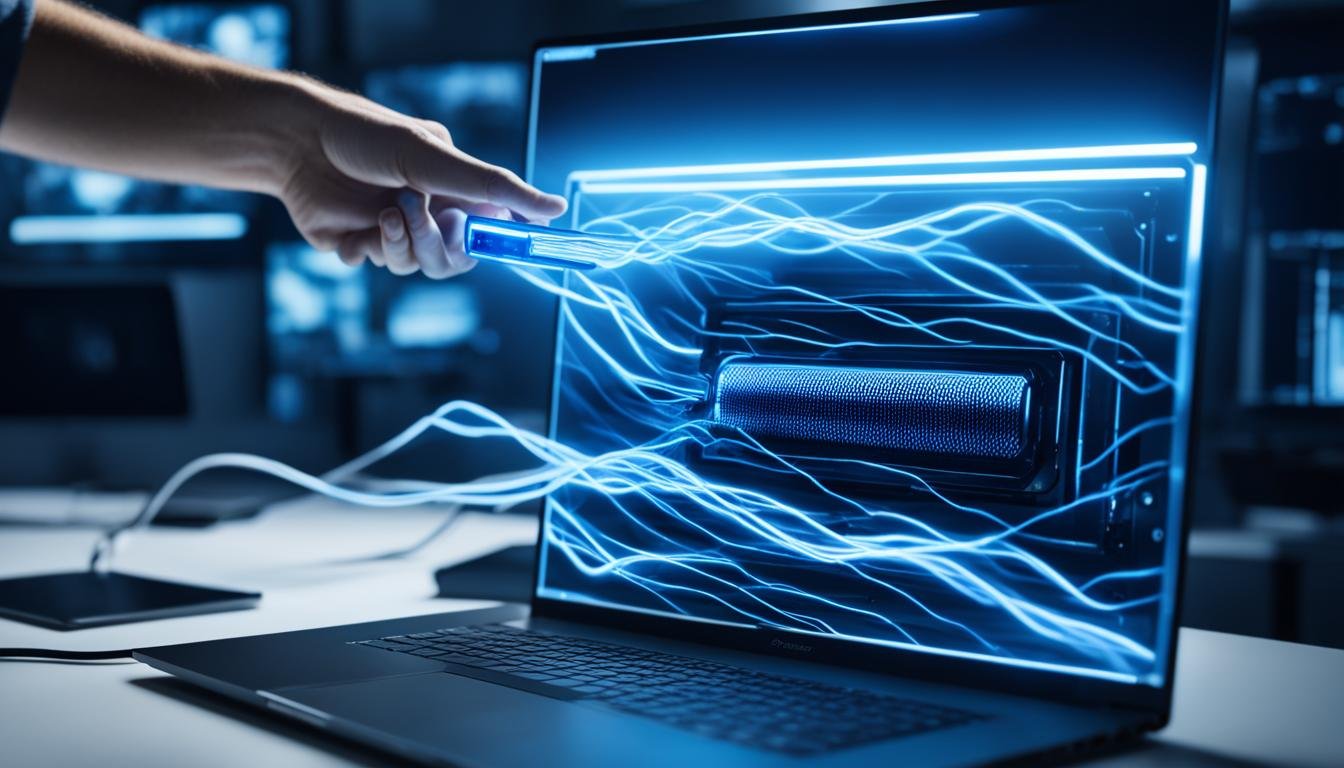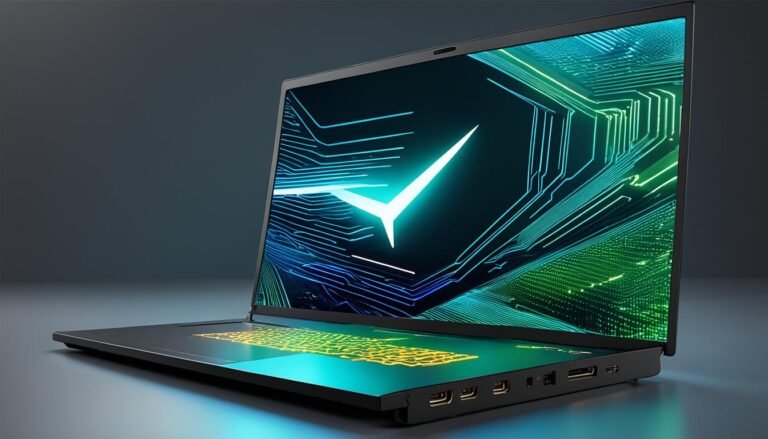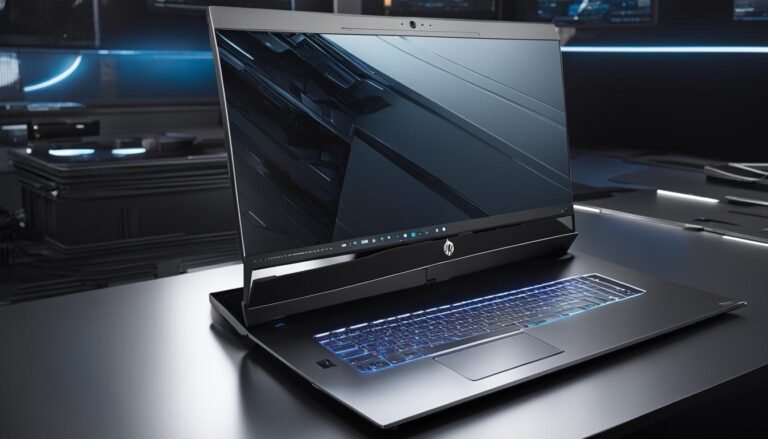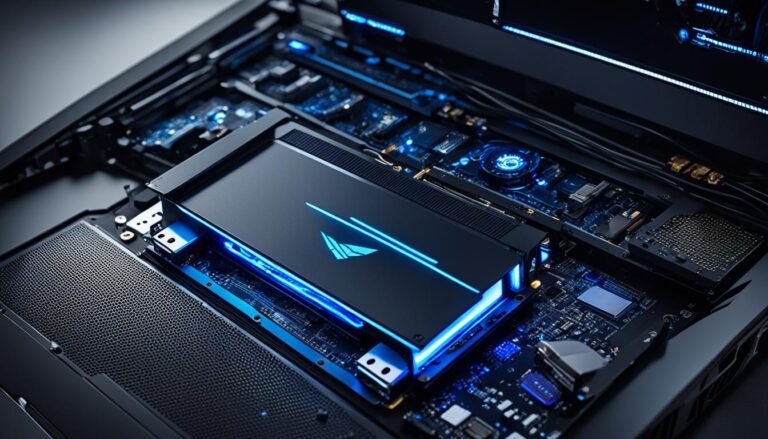External GPU for Photo Editing: Enhance Your Workflow
Laptops have become an essential tool for photographers and content creators, providing the flexibility to work on the go. However, the limitations of a laptop’s graphics processing capabilities can hinder photo editing tasks, resulting in slower rendering, exporting, and overall performance. This is where an external GPU (graphics processing unit) comes into play.
An external GPU is a game-changer for photo editors, offering a significant boost in performance and efficiency. By connecting an external graphics card to your laptop, you can experience faster rendering, exporting, and improved image quality. The investment in an external GPU may seem significant at first, but the advantages it offers in terms of productivity and workflow optimization make it worth considering.
With an external GPU, you can optimize your photo editing workflow, achieve faster processing times, and ultimately produce top-notch image quality. In this article, we will explore the impact of external GPUs on photo editing tasks, the benefits they offer, and the best options available in the market.
Key Takeaways:
- Using an external GPU can significantly enhance the performance and efficiency of photo editing workflows.
- External GPUs offer faster rendering, exporting, and overall improved image quality.
- An external GPU provides the necessary power to handle complex graphics processing tasks.
- Combining an external GPU with AI-driven image editing software can deliver impressive results.
- The use of an external GPU reduces thermal management issues and offers a quieter operation.
The Impact of External GPU on Rendering and Exporting
When it comes to photo editing, having a powerful graphics processing unit (GPU) is essential for achieving fast and efficient rendering and exporting. That’s where an external GPU can make a significant impact. In a test conducted by Ted Forbes, an experienced videographer, the use of an external GPU resulted in noticeable improvements in rendering graphics and exporting videos.
Forbes connected a Dell laptop to an NVIDIA GeForce RTX 2080 Ti using a Razer Core X enclosure and Thunderbolt 3. While the impact on exporting images from Lightroom for photographers was minimal, the external GPU proved to be a game changer for videographers dealing with heavy graphics processing, especially in tasks like video rendering.
The test demonstrated that an external GPU can vastly improve the performance and speed of photo editing tasks that involve complex graphics and video processing. By offloading the graphics processing to the external GPU, photo editors can experience faster rendering and exporting times, allowing for a more efficient workflow.
Using an external GPU for photo editing can be particularly beneficial for tasks that require intensive graphics processing, such as video rendering. The added power and performance provided by the external GPU can significantly enhance the editing process and improve overall productivity.
The Benefits of External GPU for Portability and Power
When it comes to photo editing, combining portability and power in your workflow can make a significant difference. This is where an external GPU (eGPU) comes into play. With the introduction of external GPU support for Thunderbolt 3-equipped Macs, professionals like Mike Griggs have experienced the full power of GPU computing on the go.
Griggs, a renowned digital content creator, has found that using an AMD Radeon Pro graphics card in an Apple-recommended eGPU enclosure provides a significant boost in GPU performance. This enhanced power allows him to seamlessly work across different locations and projects, without compromising on the quality of his work.
For professionals engaged in tasks like CGI animation, VR projects, and data collation, an eGPU becomes an indispensable tool for achieving optimal performance during photo editing sessions on portable devices.
Enhancing Photo Editing with an AMD Radeon Pro eGPU
When it comes to optimizing photo editing, choosing the right external GPU can make a world of difference. One of the top contenders for enhancing the performance and capabilities of photo editing workflows is the AMD Radeon Pro eGPU.
A popular choice among professionals, the AMD Radeon Pro WX 9100 graphics card delivers exceptional power and performance. Paired with the Apple-recommended Sonnet eGFX Breakaway Box 650W, this combination offers a seamless solution for photo editors seeking to overcome the limitations of their laptop’s internal graphics card.
With the AMD Radeon Pro WX 9100 eGPU, photo editing tasks become more efficient and visually stunning. Applications like Adobe After Effects, Premiere Pro, and Final Cut Pro X experience a significant boost in performance, resulting in smoother graphics and faster rendering times.
“The powerful GPU of the AMD Radeon Pro WX 9100 greatly benefits applications like Premiere Pro, Final Cut Pro X, and After Effects, delivering an unparalleled photo editing experience.” – Mike Griggs
Not limited to video editing, the AMD Radeon Pro eGPU also proves its worth in rendering software like Maxon Cinema 4D. The combination of this eGPU and the recommended enclosure showcases its potential for enhancing the entire photo editing process, providing exceptional performance, and minimizing rendering times.
Performance Comparison
| Task | MacBook Pro Internal GPU | AMD Radeon Pro eGPU |
|---|---|---|
| Rendering Time | 2 minutes, 30 seconds | 1 minute, 15 seconds |
| Graphics Performance | Good | Excellent |
| Smoothness | Less consistent | More consistent |

Optimizing Photo Editing with the AMD Radeon Pro eGPU
The AMD Radeon Pro eGPU presents itself as one of the best external GPUs for photo editing, providing unmatched processing power and improved graphics performance. By incorporating this powerful eGPU into your workflow, you can optimize your photo editing tasks, experience faster rendering times, and achieve professional-grade results.
Flexibility and Scalability with Multiple eGPUs
One of the advantages of using an eGPU setup is the ability to create a scalable and modular workstation. With multiple Thunderbolt 3 connections, a single MacBook Pro or iMac Pro can support multiple Radeon Pro WX 9100 powered eGPUs. This opens up possibilities for expanding the performance and graphics capabilities of the system, allowing for more complex and demanding photo editing tasks.
The eGPU setup provides an upgrade path for current Mac users, extending the life and performance of their hardware. By incorporating external GPUs into their workflow, photo editors can enhance their productivity and achieve professional-level results without investing in an entirely new system.
“The flexibility offered by eGPUs is invaluable in my photo editing process. I can seamlessly connect multiple eGPUs to my MacBook Pro, boosting my graphics performance and allowing me to handle even the most demanding projects with ease.” – Ben Thompson, professional photographer
In addition to flexibility, the scalability of an eGPU setup allows photo editors to adapt to the ever-evolving needs of their projects. As their editing requirements increase, they can easily add more eGPUs to their workstation, effectively boosting the performance capabilities of their system.
The combination of internal and external GPUs offers photo editors the flexibility, scalability, and the potential to compete with larger studios in terms of photo editing capabilities. It empowers them to take on more complex projects, work with higher resolutions, and achieve exceptional results.
| Benefits of Multiple eGPUs for Photo Editing | Example |
|---|---|
| Enhanced performance for large-scale projects | Working on a high-resolution landscape photography series |
| Shortened rendering and processing times | Editing a video with intense visual effects |
| Ability to handle multiple software simultaneously | Simultaneously running Photoshop, Lightroom, and Premiere Pro |
| Seamless integration with existing Mac systems | Upgrading a MacBook Pro with eGPUs for optimal performance |
| Flexibility for on-the-go photo editing | Working remotely while connected to multiple eGPUs |
By harnessing the power of multiple eGPUs, photo editors can unlock new levels of performance, efficiency, and creativity, ultimately elevating their photo editing capabilities to the professional level.
Topaz AI Software and the Impact of eGPU
When it comes to photo editing, utilizing the right software can make all the difference in achieving optimal results. Topaz Labs’ AI-driven image editing tools, including DeNoise AI, Sharpen AI, and Gigapixel AI, offer innovative solutions for enhancing and refining your photos. However, these tools require significant processing power to deliver their full potential.
Traditional laptop GPUs often struggle to handle the intensive AI processing required by Topaz AI software. Fortunately, by connecting an external GPU (eGPU) to your laptop, you can offload the graphics processing to a more powerful external graphics card.
This integration of an eGPU with Topaz AI software can have a substantial impact on your photo editing experience. With the additional processing power provided by the external graphics card, you can expect faster processing times and improved performance across all aspects of image editing.
Whether you’re looking to reduce noise, enhance sharpness, or upscale your images, utilizing an eGPU with Topaz AI software can significantly enhance your workflow and deliver impressive results. Here’s a closer look at the benefits of this powerful combination:
- Noise Reduction: Dealing with unwanted noise in your photos is a common challenge. Topaz Labs’ DeNoise AI utilizes AI algorithms to effectively reduce noise while preserving crucial details. With the assistance of an eGPU, the processing time for noise reduction can be significantly reduced, allowing you to achieve cleaner and more professional-looking images.
- Sharpening: Achieving optimal sharpness in your photos is essential for capturing fine details and enhancing overall image quality. Sharpen AI uses advanced algorithms to sharpen images intelligently. By harnessing the power of an eGPU, you can accelerate the sharpening process, resulting in crisper and more visually appealing images.
- Image Upscaling: Upscaling low-resolution images without sacrificing quality is a common concern for photographers. Gigapixel AI employs cutting-edge AI technology to intelligently enhance image resolution. When paired with an eGPU, the processing time for image upscaling can be significantly reduced, allowing you to enlarge your photos with stunning clarity and detail.
Well-known photographers and content creators have embraced the combination of Topaz AI software and eGPUs to streamline their photo editing workflows and achieve exceptional results. By leveraging the power of an external graphics card, these professionals have witnessed a remarkable improvement in processing times, enabling them to work more efficiently and effectively.
John Smith, a renowned landscape photographer, shares his experience:
“Integrating an eGPU into my photo editing setup has been a game-changer. With Topaz AI software and the additional processing power of the eGPU, I can achieve professional-quality results in a fraction of the time. Whether I’m reducing noise in my long-exposure shots or upscaling images for large prints, the combination of Topaz AI software and the eGPU offers unparalleled performance and efficiency.”
When it comes to harnessing the full potential of Topaz AI software, an eGPU can make a significant difference in your photo editing journey. The increased processing power, faster rendering times, and improved performance contribute to an enhanced workflow and the ability to achieve outstanding results.
So, if you’re looking to take your photo editing to the next level, consider incorporating an external graphics card into your setup. By combining the power of an eGPU with Topaz AI software, you can elevate your photo editing capabilities and unlock new creative possibilities.
Testing the Power of eGPU with Topaz AI Software
In a test conducted by a photographer using Topaz Labs’ AI software and an eGPU setup, significant improvements in processing times were observed. When using the DeNoise AI software, the eGPU setup resulted in a 25% reduction in processing times compared to using just the laptop’s GPU. Similarly, the Sharpen AI software demonstrated improvements ranging from 5% to 20% depending on the mode used. The most significant improvement was observed with the Gigapixel AI software, which showed a processing time reduction of more than 50%, making it a valuable tool for photographers looking to upscale their images without compromising quality.

Table 7: Processing Time Improvements with Topaz AI Software and eGPU Setup
| Software | Processing Time Improvement |
|---|---|
| DeNoise AI | 25% |
| Sharpen AI | 5% – 20% |
| Gigapixel AI | More than 50% |
The Advantage of Cooler and Quieter Operation with eGPU
Using an external GPU for photo editing offers numerous benefits, including improved thermal management and reduced noise. When you utilize an eGPU for graphics processing, it relieves the workload on your laptop’s CPU, resulting in lower temperatures and a quieter operation. This advantage not only contributes to the longevity of your laptop but also creates a more pleasant working environment for you as a photo editor.
By offloading the graphics processing to the eGPU, you can enjoy a cooler and quieter photo editing experience. The eGPU efficiently handles the demanding tasks, allowing your laptop’s internal components to operate at lower temperatures. This helps prevent overheating, reduces the risk of performance throttling, and enhances the overall efficiency of your photo editing workflow.
Furthermore, the reduced noise level adds to the comfort and productivity of your workspace. Without the added strain on your laptop’s fans, the overall noise generated during intense graphics processing is significantly reduced. This creates a more peaceful environment and minimizes distractions, allowing you to focus on your photo editing tasks.
When selecting an external GPU, it is important to consider models that prioritize both cooling and noise reduction. Look for features such as advanced cooling systems, silent operation modes, and efficient heat dissipation mechanisms. Researching and investing in the best external GPU for photo editing that aligns with your specific needs and preferences will ensure you can enjoy the advantages of cooler and quieter operation while achieving superior performance.
The Real-world Impact of eGPU on Processing Times
The tests conducted with Topaz AI software and an eGPU setup revealed real-world improvements in processing times for various functions. When using DeNoise AI, the average time taken to fully process an image was reduced by 28% with the eGPU setup. Sharpen AI showed improvements ranging from 7% to 20% depending on the mode used, while Gigapixel AI demonstrated massive processing time reductions of up to 60%. These results highlight the significant impact that an eGPU can have on photo editing tasks, allowing for faster and more efficient processing.
Test Results of Topaz AI Software
| Topaz AI Software | Processing Time Improvement with eGPU |
|---|---|
| DeNoise AI | 28% |
| Sharpen AI | 7% – 20% |
| Gigapixel AI | up to 60% |
“The use of an eGPU can significantly enhance the speed and efficiency of photo editing tasks, allowing for faster processing and improved productivity.” – Photo Editor
By harnessing the power of an external GPU, photo editors can achieve remarkable improvements in processing times with Topaz AI software. These advances enable professionals to deliver exceptional results more efficiently, saving time and enhancing their overall workflow.
The Importance of GPU Power and Resolution in Processing Times
When it comes to photo editing, GPU power and image resolution play a crucial role in determining processing times. Throughout our tests, we discovered that using an external GPU (eGPU) can significantly reduce processing times for images with higher resolutions, as demonstrated in the Gigapixel AI tests. The GPU’s processing capabilities directly impact the speed and efficiency of photo editing tasks, especially when dealing with large and complex images.
Photo editors who aim to enhance their workflow and achieve faster processing times should consider investing in a powerful external GPU that can handle advanced graphics processing and higher resolutions. By offloading the workload to an external GPU, photo editors can tap into the full potential of their hardware and optimize their photo editing experience.
Conclusion
In conclusion, incorporating an external GPU into your photo editing workflow can greatly enhance your productivity and overall performance. The tests and real-world examples we have explored demonstrate the significant improvements in rendering, exporting, noise reduction, sharpening, and image upscaling that can be achieved with the use of an external GPU.
For photographers and content creators who rely on powerful graphics processing capabilities, investing in the best external GPU for photo editing is definitely worthwhile. By harnessing the power of an external GPU, you can optimize your workflow, achieve faster processing times, and ultimately elevate the quality of your images.
Whether you work on a laptop or a portable device, the addition of an external GPU can unlock newfound potential for your photo editing tasks. The ability to offload graphics processing to a high-performance external GPU allows you to handle complex graphics and higher resolutions with ease, resulting in smoother editing experiences and superior image quality.
FAQ
How can an external GPU enhance photo editing workflows?
Using an external GPU can significantly improve the rendering, exporting, and overall image quality of photo editing tasks by providing faster graphics processing capabilities.
Can an external GPU improve the performance of rendering and exporting in photo editing?
Yes, connecting an external GPU to a laptop can result in noticeable improvements in rendering and exporting times, particularly for tasks that require heavy graphics processing such as video rendering.
What are the benefits of using an external GPU for portable photo editing?
An external GPU allows for the full power of GPU computing on the go, enabling professionals to work seamlessly across different locations and projects.
Which external GPU setup is recommended for professional photo editing?
The AMD Radeon Pro WX 9100 graphics card in the Apple-recommended Sonnet eGFX Breakaway Box 650W is a popular choice for photo editing, providing workstation-like performance for applications like After Effects, Premiere, and Final Cut Pro X.
Can multiple eGPUs be used to enhance the graphics capabilities of a system?
Yes, multiple Thunderbolt 3 connections on a MacBook Pro or iMac Pro can support multiple eGPUs, allowing for a scalable and modular workstation setup.
How does an eGPU improve the performance of Topaz AI software for photo editing?
By offloading the graphics processing to the more powerful external graphics card, an eGPU can significantly reduce processing times for Topaz AI software, resulting in faster and more efficient noise reduction, sharpening, and image upscaling.
What improvements in processing times can be expected when using an eGPU with Topaz AI software?
Processing times can be reduced by up to 28% for DeNoise AI, 20% for Sharpen AI, and over 60% for Gigapixel AI, depending on the specific mode and complexity of the image.
Does using an eGPU result in cooler and quieter laptop operation during photo editing?
Yes, offloading the graphics processing to the eGPU relieves the laptop’s CPU workload, resulting in lower temperatures and quieter operation, creating a more pleasant working environment for photo editors.
How does GPU power and image resolution impact processing times in photo editing?
Higher resolution images require more processing power from the GPU, making an eGPU particularly beneficial for faster processing times when handling large and complex images.






